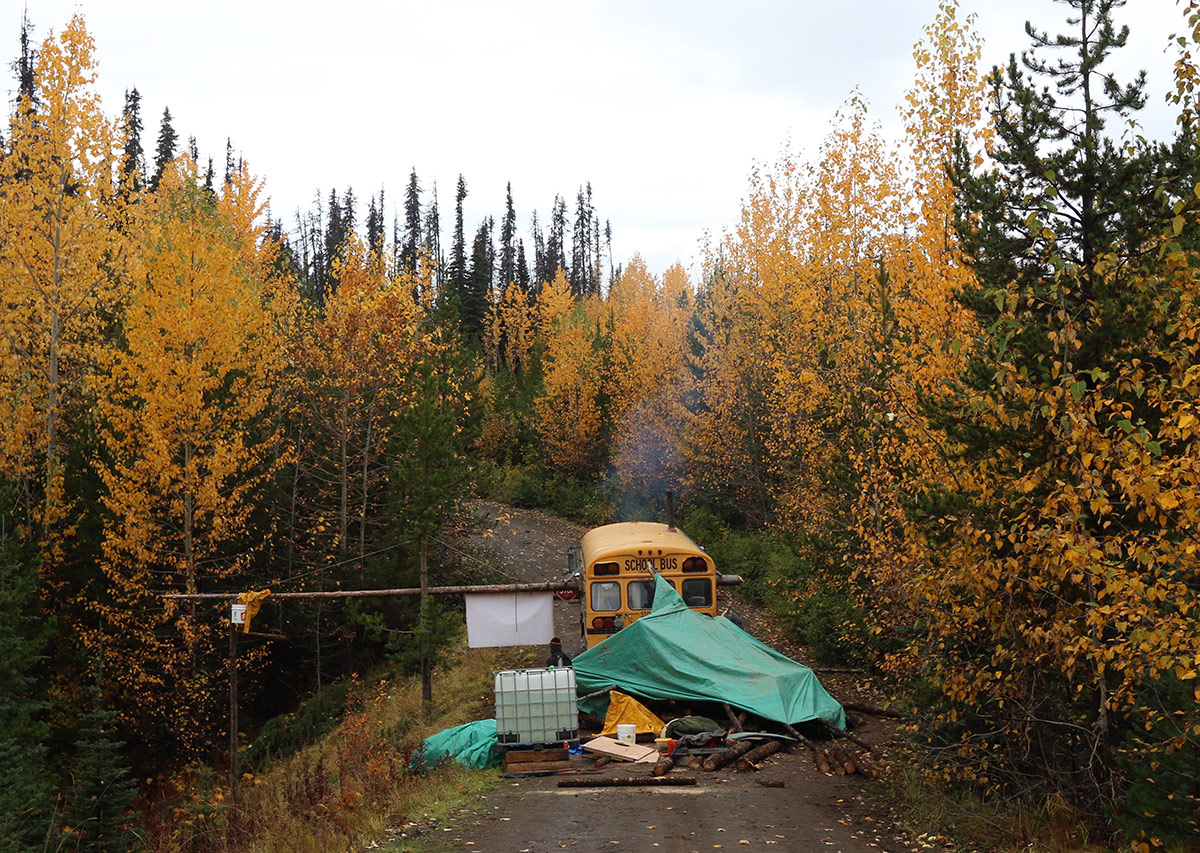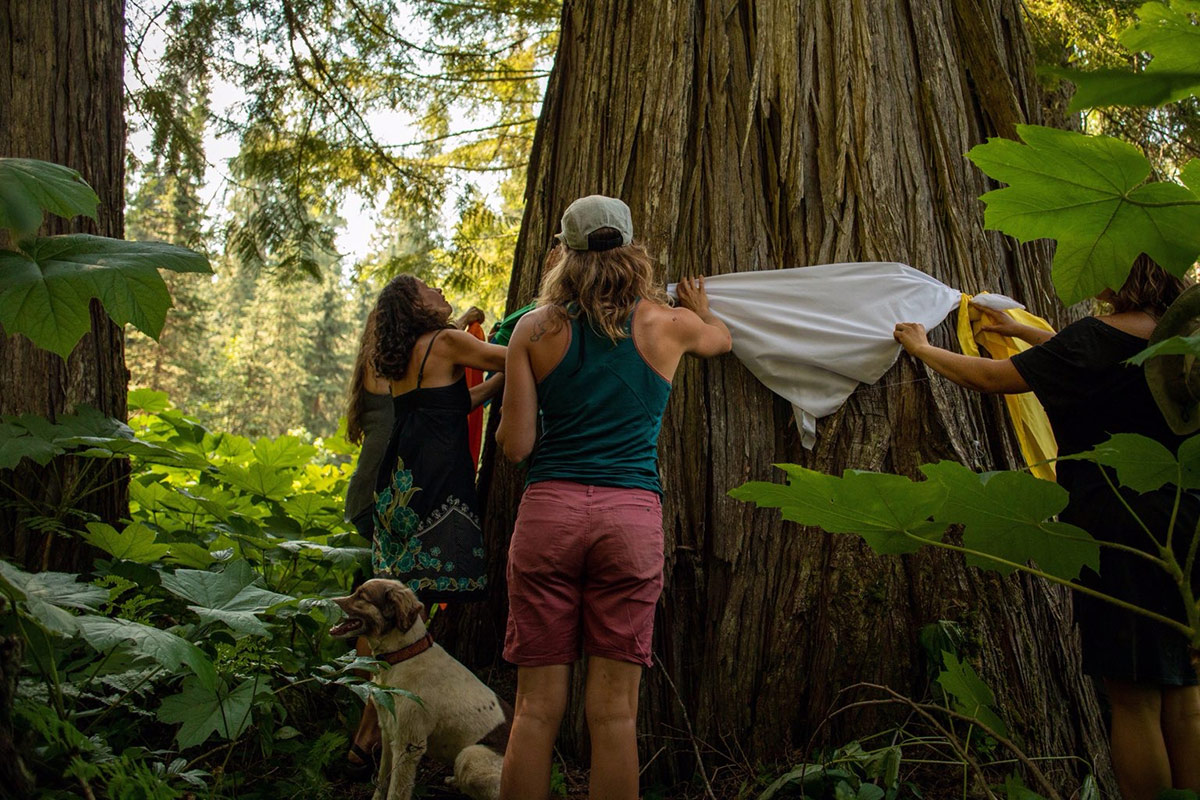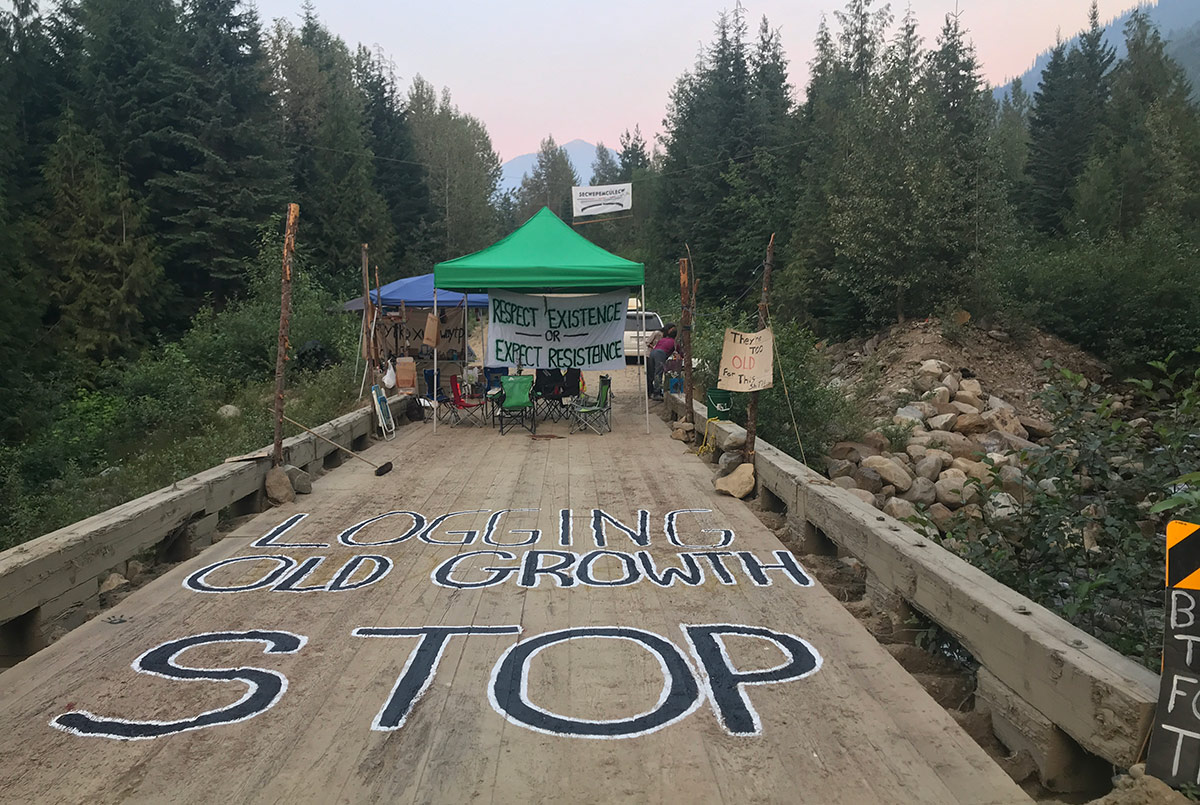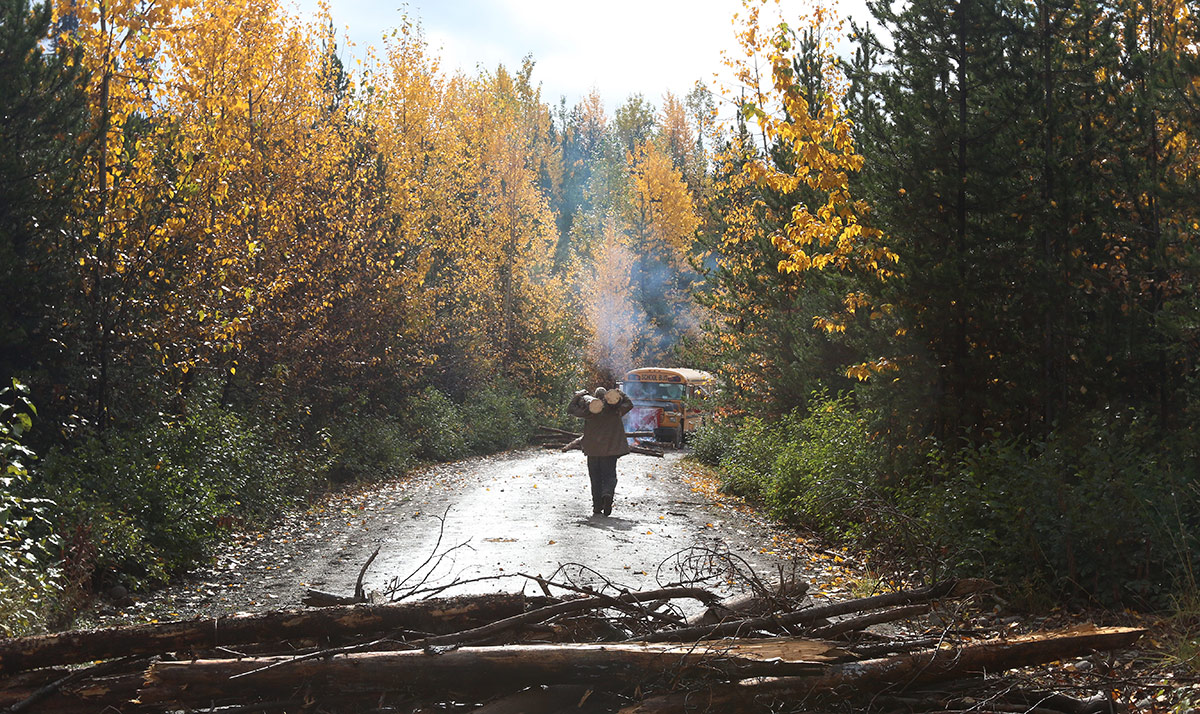Sixty-three kilometres down a rough resource road, land defenders busy themselves reinforcing barricades. They haul logs and dig holes, creating so-called beaver dams, sleeping dragons and cantilevered swings — devices known as “hard blocks.”
They are defying a court injunction and face arrests by RCMP who have already shown a willingness to wade in forcefully here at Coyote Camp, as its inhabitants call their outpost.
If there is another police raid, the land defenders will latch themselves to the devices. Their aim is to prevent — or at least slow — access to what lies beyond, a cleared area where Coastal GasLink plans to drill its 670-kilometre pipeline under the Morice River, known to the Wet’suwet’en Nation as Wedzin Kwa.
The techniques are new to the occupations on Wet’suwet’en territory, where opposition to Coastal GasLink’s gas pipeline at other sites has resulted in two major police actions in January 2019 and February 2020.
The hard block methods now being adopted are borrowed from old-growth logging protests 1,200 kilometres to the southwest on Vancouver Island, the highly publicized standoff at Fairy Creek that has continued for over a year and resulted in more than 1,100 arrests.
Some of the Fairy Creek land defenders, too, have made the trip north, lending their support to this occupation backed by Wet’suwet’en hereditary leadership.
As B.C.’s courts grapple over an injunction issued against the Fairy Creek blockaders, the legal outcome could have far-reaching implications for efforts to use civil disobedience to halt drilling, logging and construction in other corners of the province.
There’s no doubt that land defenders at Coyote Camp are keeping a close eye on the Fairy Creek injunction drama, where police tactics have been slammed by the B.C. Supreme Court.
In that Sept. 28 decision, Justice Douglas Thompson refused to extend the order on behalf of Teal-Jones, the logging firm clear cutting around an old-growth watershed on Vancouver Island. The justice ruled that heavy-handed RCMP practices risked harming the public’s faith in B.C.’s justice system.
But on Oct. 8, B.C. Supreme Court of Appeals Justice Sunni Stromberg-Stein temporarily reinstated the injunction, ruling that not doing so would cause Teal-Jones economic hardship while waiting for an ultimate appeal ruling.
Whether Thompson’s ruling is restored will be decided by the appeals court in November.

Last month at Coyote Camp, the RCMP made two arrests, using a Taser and other methods that land defenders describe as violent and excessively forceful. “I could hear it happening,” said Molly Wickham, whose Wet’suwet’en name is Sleydo’, recalling a man’s screams as he was taken into custody on Sept. 25. “You look at any other situation and the RCMP don’t come in on day one with Tasers.”
The land defenders have compared such tactics to those condemned by Justice Thompson, who said police actions at Fairy Creek had led to “serious and substantial infringement of civil liberties” that could bring the court into disrepute.
If Thompson’s ruling is affirmed, it will stand as a rare judicial rejection of RCMP behaviour in the context of enforcing an injunction.
“It’s quite a remarkable decision,” said Leo McGrady, a senior legal counsel with experience defending practitioners of civil disobedience. “His criticisms of their misconduct are trenchant, they’re powerful.”
Still, there is no guarantee the RCMP will actually follow directions from the court in the way they operate, said Jeffrey Monaghan, associate professor at Carleton University’s Institute of Criminology and Criminal Justice.
‘Pain compliance’ and Tasers
While the number of protesters and arrests at Camp Coyote is far smaller than at Fairy Creek, land defenders at the Wet’suwet’en site see similarities in RCMP behaviour.
The first person to be arrested on Sept. 25 was attempting to comply when officers sent an electrical charge into his body with a Taser, according to Molly Wickham.
In an email to The Tyee, Sgt. Chris Manseau with RCMP media relations confirmed the man was shocked with a Taser. “Upon police arrival, a male was operating industry heavy equipment, damaging the road and disregarding police commands,” Manseau wrote, adding the man endangered the officers while being arrested.
Land defenders said the man was attempting to turn off the machinery when it swung toward the police officers.
He was charged with breach of the injunction, obstruction and assaulting a police officer, according to police.
The second arrest took place two days later, after RCMP used a tactic the force calls “pain compliance “to remove a protester chained beneath a school bus that was blocking the road.
In a video posted to social media, officers can be seen pulling on the man’s legs as he screams in pain. Wickham says the arrest took hours as RCMP attempted to coerce the man into releasing himself and ended when Coastal GasLink mechanics were brought in to remove the bus’s drive shaft.
At one point, she wondered if the man had become unconscious. Police joked that he was taking a nap. “There were so many human rights violations,” Wickham said.
The second arrest resulted in a charge for breaching the injunction, Manseau said.
Land defenders at the site, who declined to be identified, expressed concern that having untrained industry workers do hard block extractions is both dangerous and illegal.
When asked about the legality of Coastal GasLink assisting with the person’s extraction from under a school bus, Manseau said that police retain discretion over how a protester is removed during an arrest and added that the man was “explained this process, was provided safety equipment and was not in any danger during the operation.”
Pain compliance is one of the tactics available under the RCMP’s Incident Management Intervention Model which guides police behaviour across the country. The model allows officers to step up their use of force if an individual is non-compliant, and to increase it even more if they resist.
But in practice, said Monaghan, limits on pain compliance are ambiguous. That’s because if an officer feels threatened, “that opens the threshold of violence to whatever they perceive subjectively was a necessary measure to take.” Monaghan adds that courts often give officers broad discretion on the use of force in threatening situations.
That history of discretion marks Justice Thompson’s Fairy Creek decision as an unusual departure, said Monaghan.
Justice Thompson found that overall, the RCMP’s use of force had been reasonable, but that certain instances illustrated “disquieting lapses in reasonable crowd control,” referencing videos showing RCMP ripping masks from protesters’ faces before deploying pepper spray and smashing a protester’s guitar.
But as a lower court decision, Justice Thompson’s ruling doesn’t necessarily change law or policy for the RCMP’s behaviour going forward. “What it does is it gives them a lump on the chin,” said Monaghan.
“The big question is, they’ve taken that lump on the chin, and they’ve taken a whole bunch of bad press — what are they going to change in practice?”

Monaghan added that it’s high time the RCMP make changes in the way they enforce injunctions.
“I think there’s something seriously wrong with the upper echelons of the RCMP to continue to allow this approach and not look towards other models that lessen the trauma and the violence that they are creating.”
The reasons for that violence are multilayered, said Monaghan, who points to the RCMP’s colonial history and its culture that often presents land defenders as those putting a stain on the RCMP’s public reputation.
“There’s a punitive element to what the police do at land defense demonstrations that’s not like any other conflict,” he said, “both because of the context, but also because there’s this level of antagonism between police and land defenders that’s highly ingrained into the conflict.”
Gidimt’en Clan member Jennifer Wickham said she hopes Justice Thompson’s ruling will survive appeal and send a message to police about engaging peacefully with the camp occupants.
“They can do their job without violence,” she said. “When there’s peaceful protesters who are passively locked down to things, you can extract them without hurting them. That’s possible. You’re making a choice to be violent.”
Blocking witnesses and hiding identities
In an earlier ruling from August, Justice Thompson found that police had acted unlawfully by creating extensive “exclusion zones” at Fairy Creek that limited public and media access to the region, barring some members of the media from witnessing arrests. During hearings, one journalist stated this level of control over media access was reminiscent of his reporting experience in China.
A month later, Thompson cited that decision — and the RCMP’s ongoing failure to comply with it — when he denied Teal-Jones’ attempt to extend their injunction.
Exclusion zones were also used by RCMP during last year’s standoff on Wet’suwet’en territory, resulting in Wet’suwet’en members and the media, including The Tyee, being denied access to the area. The BC Civil Liberties Association filed a complaint with the RCMP’s Civilian Review and Complaints Commission to investigate the “improper and unlawful” actions.
Media access is critical, said McGrady, whose clients include The Tyee. More media access means better coverage, and it holds RCMP accountable for their actions. “Whenever there’s been effective pushback by the public and effective criticism of excessive police conduct, it’s because there’s been videos or photographs available to the court that are independent.”
Manseau would not indicate whether RCMP would stop using those broad exclusion zones in future operations, stating that “each injunction is different, and we will enforce these mandatory directions from the court.”
When Justice Thompson ruled that broad exclusion zones were illegal at Fairy Creek, he explained that the terms of Teal-Jones’ injunction didn’t allow for them. Coastal GasLink’s injunction is similar, said Noah Ross, a lawyer working with Fairy Creek protesters.
“Both injunctions had specific clauses that indicate that people are at liberty to engage in lawful protest,” he said.
But the injunction levelled against land defenders on Wet’suwet’en territory bears a critical difference to the Fairy Creek blockade: it’s not up for review anytime soon.

In the first week of October, the RCMP bolstered forces in the area around Coyote Camp, according to local sources. Gidimt’en Clan members reported seeing vehicles with RCMP’s Community-Industry Response Group, which is tasked with “strategic oversight addressing energy industry incidents."
“We’ve seen three C-IRG vehicles around the territory and in town,” Jennifer Wickham said last week. Land defenders had previously reported that C-IRG had left the area once the Vancouver Island protests began.
By this week, that number had increased to five C-IRG vehicles, including a large-capacity passenger van, Wickham said.
Also spotted on the territory were officers who played a role in the Fairy Creek enforcement.
Staff Sgt. Jason Charney, a C-IRG officer who read the injunction to Vancouver Island protesters in May, was recorded at Coyote Camp over the weekend, emptying a cistern used for drinking water.
Land defenders say police have slashed tires and rifled through tents at the site.
They also say that RCMP have declined to provide identification in recent weeks on Wet’suwet’en territory. When asked for their names, officers have refused and deliberately covered their badges, land defenders claim.
Such anonymity was another red flag for Justice Thompson, who found that RCMP were “ordered” to remove their badge number and name during enforcement at Fairy Creek.
“It’s a dangerous sign” when RCMP hide their identities, said McGrady. “When you see them turning up without any means of identification, it means they don’t want to be accountable for what they’re about to do.”
In an emailed statement responding to Thompson’s ruling on Fairy Creek, Manseau said he is “not aware that there was an official order to remove identification badges, but rather members were given the option,” he said, adding that officers were “targeted online, doxxed and harassed” when asked for their identification,
Manseau’s argument echoes RCMP statements delivered during the injunction hearing. But Justice Thompson rejected that line of defence, stating that the same argument could be made for any official in a position of authority. “We identify ourselves. Accountability requires it,” he said.
Manseau would not indicate whether RCMP planned to change their policies around police identification but added that “consultation is currently ongoing at the national level, so I have nothing further to add at the moment.”
RCMP have declined to provide identification in recent weeks on Wet’suwet’en territory, where land defenders have described officers declining to share their names and deliberately covering their badges.
A land defender who identified himself as Sweets said he was doing a supply run along the road where Coyote Camp is located last week when he was stopped by three officers. While one recited a badge number — so quickly that Sweets said he barely caught it — none would provide names, he said.
He was issued what he describes as five “bogus” tickets. Among the citations: having an obscured licence plate on the muddy road and texting while driving, despite being out of cell range. Sweets said the officers told him the tickets meant he’d have a hard time crossing the border to the U.S. But a lawyer told Sweets “that’s complete garbage,” he said.
However the courts decide on the Fairy Creek injunction question, the protests there are creating ripple effects that reach all the way to the Coyote Camp and beyond. Pelican, an activist with Old Growth Revylution, a blockade to protest old-growth interior temperate forests from logging north of Revelstoke, said “people are coming and going” between their blockade and the frontlines at Fairy Creek at Wet’suwet’en. “We definitely are all in a network online giving support and ideas back and forth.”
Pelican believes RCMP tactics at such standoffs have raised awareness among the typically white environmental movement to the realities of police violence and racism.
“Fairy Creek and Old Growth Revylution has exposed a lot of white-privileged environmentalists clearly to stuff like police brutality, corruption in government and racism against Indigenous people,” she said. “I hope the government realizes how profound that has been on a generation of British Columbians.” ![]()
Read more: Rights + Justice, Environment

















Tyee Commenting Guidelines
Comments that violate guidelines risk being deleted, and violations may result in a temporary or permanent user ban. Maintain the spirit of good conversation to stay in the discussion and be patient with moderators. Comments are reviewed regularly but not in real time.
Do:
Do not: